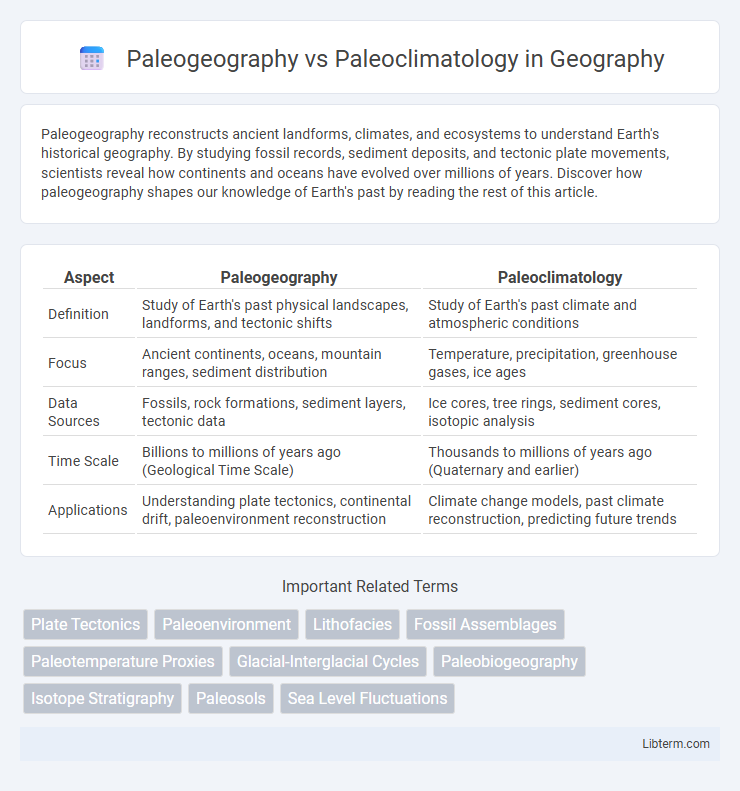Paleogeography reconstructs ancient landforms, climates, and ecosystems to understand Earth's historical geography. By studying fossil records, sediment deposits, and tectonic plate movements, scientists reveal how continents and oceans have evolved over millions of years. Discover how paleogeography shapes our knowledge of Earth's past by reading the rest of this article.
Table of Comparison
| Aspect | Paleogeography | Paleoclimatology |
|---|---|---|
| Definition | Study of Earth's past physical landscapes, landforms, and tectonic shifts | Study of Earth's past climate and atmospheric conditions |
| Focus | Ancient continents, oceans, mountain ranges, sediment distribution | Temperature, precipitation, greenhouse gases, ice ages |
| Data Sources | Fossils, rock formations, sediment layers, tectonic data | Ice cores, tree rings, sediment cores, isotopic analysis |
| Time Scale | Billions to millions of years ago (Geological Time Scale) | Thousands to millions of years ago (Quaternary and earlier) |
| Applications | Understanding plate tectonics, continental drift, paleoenvironment reconstruction | Climate change models, past climate reconstruction, predicting future trends |
Introduction to Paleogeography and Paleoclimatology
Paleogeography reconstructs ancient Earth's physical landscapes, including continents, oceans, and mountain ranges, providing critical context for understanding geological and biological evolution. Paleoclimatology studies past climate patterns using proxy data such as ice cores, sediment layers, and fossil records to interpret temperature, atmospheric composition, and precipitation changes over geological time. Together, these disciplines offer complementary insights into Earth's history by linking spatial environmental shifts with climate dynamics through deep time.
Defining Paleogeography: Study of Ancient Earth Landscapes
Paleogeography examines the distribution of ancient landmasses, oceans, and mountain ranges by reconstructing Earth's physical landscapes through geological and fossil evidence. This field provides critical insights into past plate tectonics, sedimentation patterns, and basin formations prevalent during specific geological periods, such as the Cambrian or Jurassic. Understanding paleogeography aids in interpreting the spatial context necessary for paleoclimatology, which analyzes historical climate conditions influenced by these ancient environments.
Understanding Paleoclimatology: Deciphering Ancient Climates
Paleoclimatology involves the study of ancient climates through the analysis of proxies such as ice cores, tree rings, and sediment layers, providing insights into Earth's climatic history. Unlike paleogeography, which reconstructs past geographic configurations like landmasses and ocean basins, paleoclimatology focuses on temperature, precipitation, and atmospheric composition changes over geological time. This field helps to understand patterns of climate change, including glacial and interglacial cycles, by interpreting data from geochemical signatures and fossil records.
Key Methods Used in Paleogeography Research
Paleogeography research primarily utilizes geological mapping, sediment analysis, and paleontological evidence to reconstruct ancient landforms and continental positions. Techniques such as stratigraphy, paleomagnetism, and fossil distribution studies provide critical data for understanding past geographic configurations. Remote sensing and GIS (Geographic Information Systems) also enhance spatial visualization of Earth's historical surface features in paleogeographic studies.
Major Techniques in Paleoclimatology Studies
Major techniques in paleoclimatology studies include ice core analysis, which provides detailed records of past atmospheric composition and temperature fluctuations through trapped gas bubbles and isotopic data. Sediment cores from oceans and lakes are used to reconstruct past climate conditions by analyzing fossilized microorganisms, sediment composition, and geochemical proxies such as oxygen isotopes. Tree ring analysis or dendroclimatology offers high-resolution data on past climate variability by studying growth patterns influenced by temperature and precipitation changes.
Interconnections Between Paleogeography and Paleoclimatology
Paleogeography and paleoclimatology are closely interconnected as the distribution of continents, oceans, and mountain ranges in Earth's history directly influenced ancient climate patterns, ocean currents, and atmospheric circulation. Changes in paleogeographic configurations, such as the formation of supercontinents like Pangea, shaped paleoclimate conditions by altering heat distribution and precipitation patterns globally. Understanding these interdependencies enables reconstruction of past climates and provides insights into Earth's climatic evolution and tectonic influences over geological timescales.
Case Studies: Paleogeographic Reconstructions and Climate Impacts
Paleogeographic reconstructions utilize fossil distributions, sedimentary records, and plate tectonic data to map ancient landmasses and ocean basins, providing crucial context for interpreting past climate patterns. Case studies reveal how shifting continental positions influenced ocean currents and atmospheric circulation, directly impacting paleoclimatic conditions such as glaciations and aridification. Integrating paleogeographic frameworks with climate proxies enhances understanding of Earth's climate system evolution and guides models predicting future climate scenarios.
Paleoclimate Indicators and Geographic Shifts
Paleoclimatology utilizes indicators such as ice cores, tree rings, and sediment records to reconstruct past climate conditions, revealing temperature fluctuations and atmospheric composition over geological time. Paleogeography focuses on the spatial distribution of ancient landmasses, seas, and mountain ranges, emphasizing geographic shifts driven by plate tectonics and continental drift. Integrating paleoclimate indicators with paleogeographic data allows scientists to understand how geographic transformations influenced climate patterns and ecosystem evolution during periods like the Paleozoic and Mesozoic eras.
Challenges and Limitations in Reconstructing the Past
Reconstructing past environments faces significant challenges as paleogeography relies heavily on sparse fossil records and tectonic evidence, which can be incomplete or altered by geological processes, making precise mapping difficult. Paleoclimatology encounters limitations in interpreting proxy data such as ice cores, tree rings, and sediment layers, where dating uncertainties and local environmental influences can skew climate reconstructions. Both fields struggle with temporal resolution and spatial coverage, complicating efforts to create accurate, high-resolution models of Earth's historical landscapes and climate systems.
The Importance of Paleogeography and Paleoclimatology in Modern Science
Paleogeography provides critical insights into the ancient Earth's surface configurations, including the distribution of continents and oceans, which shape modern biodiversity and natural resources. Paleoclimatology reconstructs past climate conditions, using data from ice cores, tree rings, and sediment records to understand long-term climate change and inform current models. Together, these fields are essential for predicting future environmental shifts and guiding sustainable development strategies.
Paleogeography Infographic

 libterm.com
libterm.com